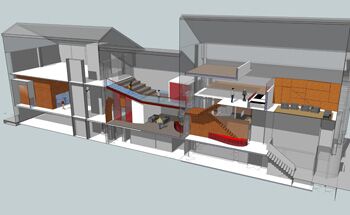Tax credits crucial in Baxter renovation
A combination of state and federal historical tax credits will make it possible for a Portland developer to eventually transform the 121-year-old Baxter Library building on Congress Street into a $4.5 million chic office building.
"Without either of them, the deal wouldn't have happened," says Josh Benthien, a partner at Northland Enterprises LLC in Portland.
State lawmakers envisioned a number of historical buildings would benefit from the state historical tax credit after it was passed into law in 2008. But the financial meltdown in September 2008 put the kibosh on many of those projects.
When the Baxter Library building project is completed this summer, Benthien says it will be one of the first ones in Maine to benefit from the state historical tax credit. The VIA Group, an advertising, marketing and branding company in Portland, will become its first tenant on Aug. 1.
A grand opening on Thursday afternoon gave invited business leaders and city officials a glimpse of what the finished product will look like when it is completed. The 24,189-square-foot building has three floors and consists of three sections that extend from its address at 619 Congress St. Benthien and his two partners, Bobby Monks and Rex Bell, hired Archetype and Scott Simons Architects, both in Portland, to come up with the design, and Benchmark Construction of Westbrook as the contractor.
Benthien says the anatomy of the financial structure of the project and the role the federal and state tax credits played is just as impressive as the building will be when construction is completed.
The state tax credit refunds 25% of the cost of renovating a certified historic structure and removes the previous $100,000 cap on an existing historic renovation credit program. The refunds come from a dedicated fund, financed through a change in the real estate transfer tax. The proposal raises the real estate transfer tax on properties above $800,000 and lowers it for sales of $600,000 or under.
The Baxter renovation earned $625,000 from the Maine historic tax credit and $500,000 from the federal historic tax credit, Benthien says.
In order to qualify for the federal tax credit, Benthien says the project must conform with National Park Service standards inside the walls because the building is listed on the National Register of Historic Places. Qualifying buildings must maintain many of the historical features inside the building, like Baxter's 15- to 18-foot high ceilings and wooden window frames on the front of the building, and receive design approval from both state and federal historic preservation agencies.
Though the renovations will include new heating and cooling systems and modern office amenities like an elevator, many historic features such as the woodwork of the library's original shelving, the marble tile floor in the basement, and an antique fireplace will be preserved.
There are two key differences between the federal historic tax credit and the state historic tax credit, Benthien says.
Under the federal tax credit, he says 20%, or $600,000, of the $3 million of the qualified historic rehab expenses of the project, goes to the developer. He says the developer can sell the tax credit to any number of corporations; they sold the federal tax credit to Tax Credit Capital LLC of New Orleans, La., for 80 cents per $1. That yielded a little less than $500,000 for the developer and Benthien says that money was applied to the project costs.
Under the state historic tax credit, the developer is entitled to 25% of the $3 million, which amounts to $750,000. But unlike the federal tax credit that can be paid out to a corporation in one year, Benthien says the state historic tax credit is paid out over four years.
"But I'm not complaining," Benthien says.
Benthien says the state law also gives developers a better price for the tax credit if they sell it to a nonprofit group. If it is sold to a for-profit business, Benthien says it would not be worth as much because it would be considered taxable income and the developer would receive 50- to 60 cents per $1. The developer gets 75 cents per $1 if the state tax credit is sold to a nonprofit group, Benthien says.
The other key element is that any nonprofit that would purchase the state tax credit must have economic development, downtown revitalization or historic preservation in its mission statement, Benthien says, or it "could run afoul of the IRS."
Fortunately, a branch of Wiscasset-based Coastal Enterprises Inc. was able to purchase the state historical tax credit, Benthien says, which produced $600,000 in cash that the developer put back into the project costs.
Benthien says the project has three different pieces of debt: a primary loan with Bangor Savings Bank and Coastal Enterprises Inc.; a secondary loan held by the Maine Rural Development Authority and a third mortgage held by the Maine College of Art, which sold the Baxter Library building to the development firm in December.
He says the city of Portland provided tax increment financing. Greg Mitchell, Portland's economic development director, says the project will generate $46,000 per year in city property tax revenue, and for the next nine years about $30,000 will be returned to the developer to help finance the project. Mitchell says the remaining $16,000 will go to the Portland Arts TIF District and the city will receive all of the new building's property tax revenues when the TIF expires 10 years after the project is completed.
A $25,000 infrastructure grant from the Downtown Portland Corp. and investor equity will pay the $200,000 in improvements required by Central Maine Power Co.
Benthien says the state and federal tax credits will generate a great deal of economic development that includes 150 construction jobs, future property tax revenue for the city on a building that was never on the city tax rolls, and The VIA Group's 65 good-paying jobs that will remain in the city. The Maine College of Art was able to use the proceeds it received from the sale of the property to expand the Porteous Building on 522 Congress St., he says.












Comments